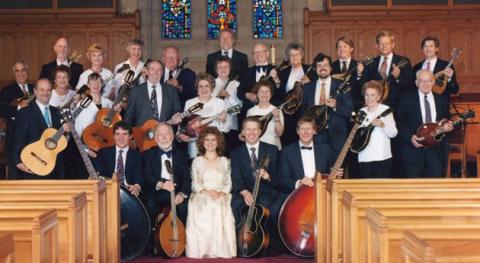History of the Baltimore Mandolin Orchestra
Origin of the Baltimore Mandolin Orchestra

The Baltimore Mandolin Orchestra was first organized in 1924 by German-born conductor, composer, and music teacher Conrad Gebelein (at left, ca. 1925).
The orchestra held its first concert in 1925. Its early concerts featured more than just mandolin-family instruments. They included performances by the orchestra's Banjo Club and Hawaiian Troupe, which played types of music that were very popular with concertgoers at the time. There were also performances by vocalists and instrumental soloists. Conrad Gebelein himself often played solos on the banjo and Hawaiian guitar. He also composed and arranged many pieces for mandolin orchestra which were premiered by the BMO.
The Baltimore Mandolin Orchestra started out with nineteen members in 1924, and by 1929 that number had almost doubled.

The Baltimore Mandolin Orchestra, 1927-1928, with director Conrad Gebelein (standing, back row, far right)
The 1930s and 1940s
The Baltimore Mandolin Orchestra flourished until 1929, when it lapsed into a period of inactivity. This was most likely due to a combination of the Great Depression and the unfortunate waning of interest in the mandolin in general throughout the country.
But in 1938 Conrad Gebelein started up the orchestra again. Some of the members of this new BMO had previously played in a mandolin orchestra that Mr. Gebelein directed at a Baltimore girls' school. This now smaller BMO gave concerts in Baltimore in 1940 and 1941. Mr. Gebelein's Hawaiian Troupe still played with the orchestra, and concerts continued to feature varied solo performances.
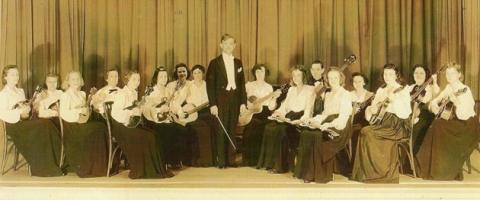
The Baltimore Orchestra, ca. 1940, with director Conrad Gebelein (standing, center)
After the United States entered World War II in December 1941 the Baltimore Mandolin Orchestra disbanded again, and Mr. Gebelein did not attempt to revive it after the war. He had many other music-related responsibilities, which included serving as music director at Johns Hopkins University, conducting a full-fledged civic symphony orchestra in Baltimore and teaching at his two music studios.
Like a Phoenix...
Many years later, in the mid-1970s, some of Conrad Gebelein's guitar students expressed an interest in playing together in some sort of ensemble. He pointed out to them that an orchestra made up solely of guitars wouldn't really sound all that good, so he got his students interested in the mandolin family of instruments instead. A mandolin ensemble would provide the plucked-string equivalent of the full voicing of a bowed-string orchestra, which guitars alone could not do.
Soon Mr. Gebelein had about fifteen serious and devoted amateur mandolin players and other instrumentalists, and in 1975--at the age of 80--he reconstituted the Baltimore Mandolin Orchestra for the third time and served again as its conductor.
The newly re-formed orchestra performed its first concert in 1975 at Johns Hopkins University. This third incarnation of the Baltimore Mandolin Orchestra continues today as a thriving, viable orchestra.
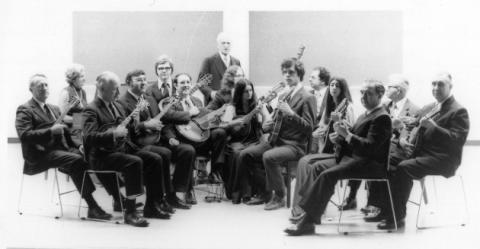
The newly re-formed Baltimore Mandolin Orchestra in 1975
with director Conrad Gebelein (standing, center rear)
The Baton is Passed
Conrad Gebelein conducted the new Baltimore Mandolin Orchestra for five years until his health failed. In late 1980, Benjamin Durant, a retired U.S. Army bandmaster and retired professor of music at the Community College of Baltimore (and son of an avid amateur mandolinist), took over as director of the orchestra.
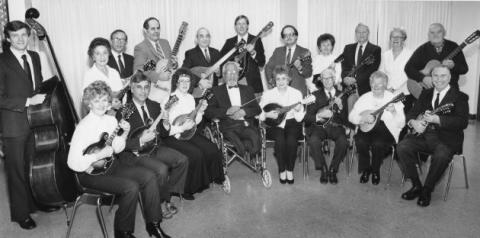
The Baltimore Mandolin Orchestra, ca. 1986, with director Benjamin Durant (center, front row)
Mr. Durant continued the fine conducting tradition of his predecessor, and the orchestra put on many well-received concerts around the Baltimore area during his tenure. BMO concerts continued to feature solo performances, including many mandolin solos by Joyce Adams, the orchestra's concertmistress. Mr. Durant devoted a great deal of effort to improving the orchestra, and he capably led the BMO until his untimely death in 1986.
Still Going Strong!
David T. Evans, who had been a member of the Baltimore Mandolin Orchestra since 1982, succeeded Benjamin Durant as director on short notice after Mr. Durant's untimely death in 1986. Mr. Evans conducted the orchestra for many years until his retirement in October 2011.
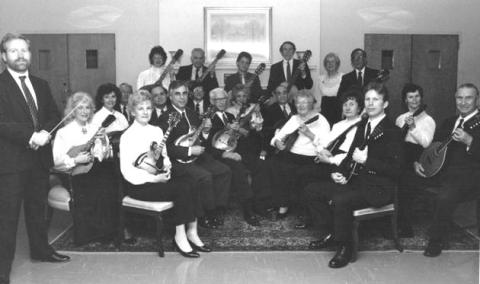
The Baltimore Mandolin Orchestra, 1988, with director David T. Evans (standing at left)
Mr. Evans had played the mandolin since 1974. He studied classical guitar and music education at the Peabody Conservatory in Baltimore.
The orchestra grew in size and matured musically under Mr. Evans' leadership, and it received many favorable reviews of its performances during the years of his tenure. Since 1994 Italian-born soprano Beatrice Gilbert has contributed her show-stopping vocal talents to the orchestra's performances.
